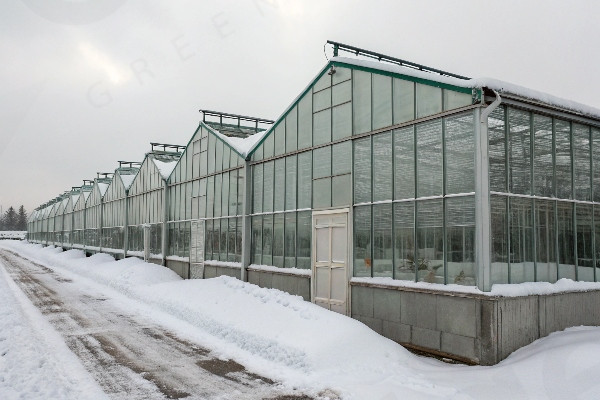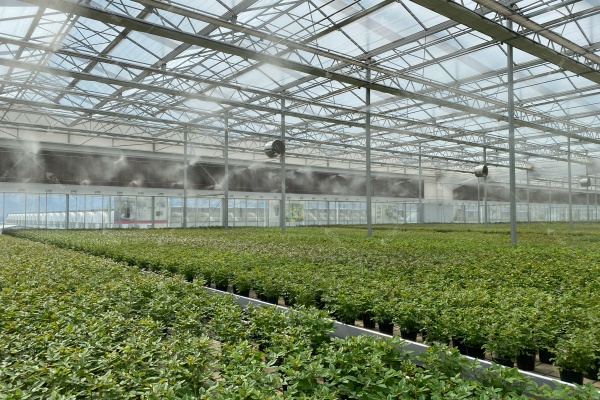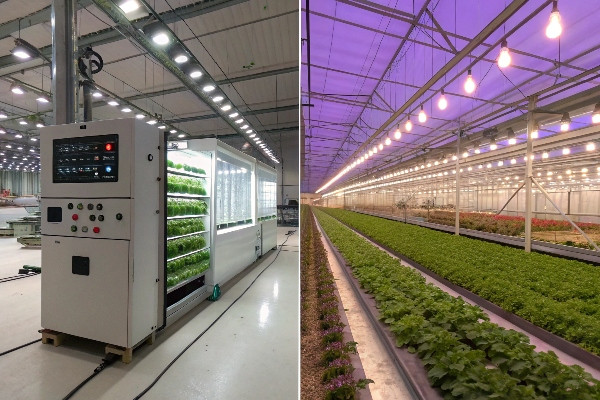Winter heating costs can destroy your greenhouse profits. Every grower faces this challenge when cold weather arrives. Smart heating choices save thousands of dollars yearly.
The cheapest greenhouse heating combines free natural methods with strategic insulation systems. Use solar gain, thermal mass, composting heat, and proper windbreaks to cut heating costs by 60-80% while maintaining optimal growing conditions.

After 29 years in the greenhouse industry, I have seen countless growers struggle with winter heating bills. The key is not just finding cheap heat sources. You need a complete system that captures free energy and keeps that warmth inside your greenhouse. Let me share the most effective low-cost heating strategies that work in real commercial operations.
Don’t Miss:——Commercial Hydroponic Greenhouse Systems: How Do Design, Construction, and ROI Interconnect?
You might like:——What is a Smart Greenhouse? The Ultimate Guide to Automated Growing
Can You Use Natural Light and Covers for Free Heating?
Solar energy costs nothing, but most growers waste this free heat source. Your greenhouse design determines how much solar gain you capture during winter months.
Yes, natural light and thermal covers provide significant free heating. Proper solar orientation, thermal mass systems, and night insulation can reduce heating needs by 40-50% even in cold climates.
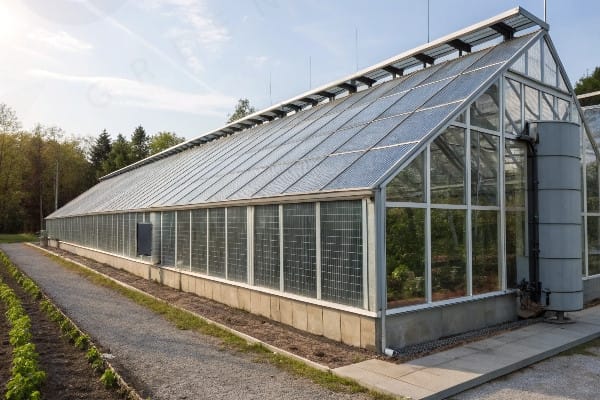
The science behind solar greenhouse heating is straightforward, but the application requires careful planning. During my years designing greenhouse systems across different climates, I learned that solar gain works best when you combine multiple strategies.
Maximizing Solar Collection
Your greenhouse orientation makes the biggest difference in solar heat collection. I always recommend positioning the longest side facing south to capture maximum winter sun. The angle matters too. In northern regions, a slight south-facing slope on your roof increases solar gain by 15-20% during winter months.
Thermal mass storage is where most growers miss opportunities. Water barrels, concrete floors, and stone walls absorb heat during sunny days and release it slowly at night. I have installed systems where 55-gallon water drums painted black store enough heat to maintain temperatures 8-10 degrees higher than outside air temperature.
Double-Layer Covering Systems
At CFGET, we design double-wall polycarbonate and inflated plastic film systems that trap insulating air. This creates a greenhouse effect within your greenhouse. The outer layer captures solar energy while the inner layer prevents heat loss. Our clients in Central Asia report 30-40% heating cost reductions with proper double-wall systems.
| Solar Heating Method | Cost Reduction | Installation Difficulty | Best Climate |
|---|---|---|---|
| Thermal Mass Water Barrels | 15-25% | Easy | All regions |
| Double-Wall Polycarbonate | 30-40% | Medium | Cold climates |
| Solar Collectors | 40-60% | Hard | Sunny regions |
| Automated Thermal Curtains | 20-35% | Medium | All regions |
Night insulation systems are crucial for retaining solar heat. Thermal curtains automatically close at sunset to trap the day’s collected warmth. I have seen greenhouse temperatures stay 15-20 degrees warmer with automated thermal curtain systems compared to single-layer greenhouses.
What DIY Materials Can Be Used for Greenhouse Insulation?
Many effective insulation materials cost very little or can be found for free. Creative growers use everything from bubble wrap to recycled materials for winter protection.
Bubble wrap, old blankets, hay bales, and recycled plastic create effective DIY insulation. These materials can reduce heat loss by 25-40% when properly installed around greenhouse walls and roofs.
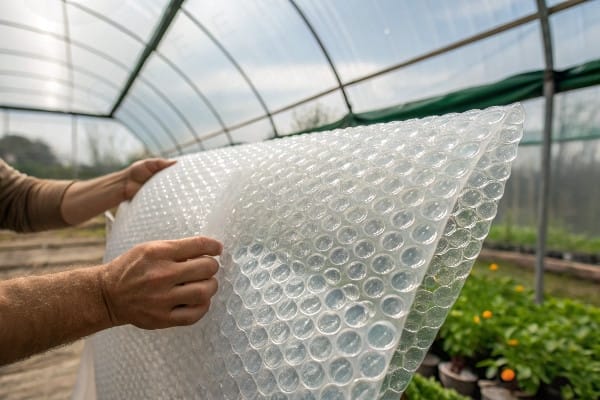
The most successful DIY insulation projects I have witnessed combine multiple low-cost materials strategically. You do not need expensive commercial insulation to achieve professional results.
Bubble Wrap Window Insulation
Large bubble wrap creates an excellent insulating layer against greenhouse walls and roofs. The air pockets trap heat while still allowing light transmission. I recommend using horticultural bubble wrap with larger bubbles for better insulation values. Attach it with clips or spray adhesive for easy seasonal removal.
The effectiveness of bubble wrap surprised me when I first tested it. A single layer reduces heat loss by 20-30% while maintaining 85% light transmission. Double layers increase insulation but reduce light to 70%. For winter heating savings, this trade-off usually makes financial sense.
Earth Berming and Hay Bale Walls
Building earth berms or stacking hay bales around your greenhouse perimeter creates natural insulation. Soil temperatures stay more stable than air temperatures. A three-foot earth berm can maintain ground temperatures 10-15 degrees warmer than air temperatures during winter.
Hay bales work similarly but install faster. Stack them two or three high around north and west walls where winter winds hit hardest. The organic matter in hay provides good insulation while slowly decomposing to generate small amounts of heat.
Recycled Material Solutions
I encourage growers to use recycled materials creatively. Old carpet padding, foam boards from construction sites, and even cardboard layers provide insulation value. The key is protecting these materials from moisture while maintaining air circulation.
| DIY Insulation Material | R-Value per Inch | Cost per Sq Ft | Durability |
|---|---|---|---|
| Bubble Wrap | 1.0-1.5 | $0.10-0.20 | 2-3 years |
| Hay Bales | 2.0-3.0 | $0.15-0.25 | 1-2 years |
| Foam Board (used) | 3.5-5.0 | $0.20-0.40 | 5-10 years |
| Reflective Bubble | 1.2-2.0 | $0.25-0.35 | 3-5 years |
Reflective materials deserve special attention. Reflective bubble wrap or emergency blankets on north walls reflect heat back into the greenhouse while providing insulation. This dual function makes them particularly valuable for DIY projects.
Can Heat from Compost or Livestock Be Utilized?
Biological heat sources generate warmth through natural decomposition processes. These methods work especially well in integrated agricultural systems where waste materials become heating fuel.
Compost piles and livestock areas generate substantial heat through decomposition and animal metabolism. Hot composting systems can maintain 140-160°F temperatures while livestock areas stay 20-30 degrees warmer than outside air.

I have helped many growers integrate biological heating systems into their greenhouse operations. These systems work best when you understand the science behind biological heat generation and plan your systems accordingly.
Hot Composting Systems
Active compost piles generate impressive amounts of heat. A well-built compost system maintains internal temperatures between 140-160°F for several weeks. I have installed compost heating systems where pipes run through active compost piles to heat water or air for greenhouse circulation.
The key to compost heating is maintaining proper carbon-nitrogen ratios and moisture levels. I recommend a 30:1 carbon to nitrogen ratio with 50-60% moisture content. Turn the pile every 3-4 days to maintain oxygen levels and heat generation.
Jean Pain composting systems1 work particularly well for greenhouse heating. These systems use wood chips and organic matter in wire cages with water circulation pipes. A single 6-foot diameter Jean Pain system can heat a 20×30 greenhouse for 6-8 months.
Livestock Integration
Connecting livestock areas to greenhouse spaces provides natural heating. Chickens, rabbits, and goats generate body heat and warm carbon dioxide that benefits plant growth. I design systems where livestock areas connect to greenhouse spaces through controlled ventilation.
The heat output varies by animal type and housing design. Chickens generate about 10-15 BTU per hour per bird. A flock of 50 chickens produces enough heat to warm a small greenhouse 10-15 degrees above outside temperature.
Underground Heat Storage
Compost heat can be stored underground in thermal mass systems. Bury water tanks or thermal mass near active compost areas to capture and store heat for nighttime use. This creates a 24-hour heating cycle from biological sources.
| Heat Source | BTU Output | Duration | Setup Cost |
|---|---|---|---|
| Hot Compost Pile | 50,000-100,000 BTU/day | 30-60 days | $50-200 |
| Jean Pain System | 200,000-400,000 BTU/day | 6-8 months | $300-800 |
| Chicken Coop (50 birds) | 12,000-18,000 BTU/day | Continuous | $200-500 |
| Rabbit Hutches | 8,000-12,000 BTU/day | Continuous | $150-400 |
The integration of these biological systems requires careful planning for air quality and disease prevention. Proper ventilation systems ensure healthy air exchange while capturing beneficial heat and carbon dioxide.
How Do Windbreaks Help Reduce Heating Costs?
Wind removes heat from greenhouse surfaces faster than still air. Strategic windbreaks can reduce heating needs by blocking cold winter winds from hitting your greenhouse directly.
Effective windbreaks reduce wind speed by 50-80% and can lower heating costs by 20-30%. Proper windbreak placement creates calm microclimates that maintain higher temperatures around greenhouse structures.
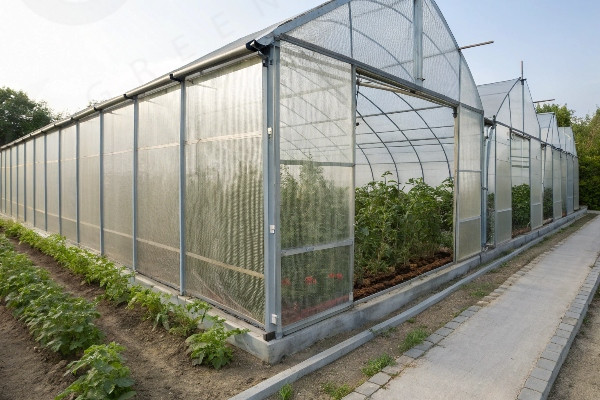
Wind protection is often overlooked but creates significant heating savings. During my work in Central Asia, where winter winds reach extreme speeds, proper windbreaks make the difference between profitable and unprofitable greenhouse operations.
Natural Windbreak Systems
Trees and shrubs create excellent long-term windbreaks. Evergreen species work best for winter protection. Plant windbreaks 100-150 feet from your greenhouse at a height equal to 1.5 times the greenhouse height for maximum effectiveness.
The porosity of windbreaks affects their performance. Solid barriers create turbulence. Windbreaks with 30-40% porosity reduce wind speed most effectively while preventing turbulent air flow. This is why living windbreaks often outperform solid fences.
Fast-growing species like hybrid poplars, willows, and evergreen shrubs establish windbreaks quickly. I recommend planting multiple rows with different heights to create graduated wind protection.
Artificial Windbreak Structures
Immediate wind protection requires artificial barriers. Snow fencing, shade cloth, and custom windbreak materials install quickly and provide instant protection. These work especially well while waiting for natural windbreaks2 to grow.
At CFGET, we design custom windbreak systems3 using agricultural fabric and steel posts. These systems reduce wind speed by 60-70% and can be relocated as needed. The fabric allows some air movement while blocking the strongest winds.
Angled windbreaks perform better than vertical barriers. A 15-20 degree backward slope creates better airflow patterns and reduces turbulence near the greenhouse. This design also handles snow loads better in northern climates.
Integrated Design Approaches
The most effective windbreak systems3 integrate with greenhouse design. Our greenhouse designs include exterior slopes that serve as both windbreaks and additional insulation layers. These slopes create double-wall effects for film greenhouses while providing wind protection.
| Windbreak Type | Wind Reduction | Installation Cost | Maintenance |
|---|---|---|---|
| Evergreen Trees | 60-80% | $2-5 per foot | Low |
| Snow Fencing | 50-70% | $1-3 per foot | Medium |
| Custom Fabric | 60-75% | $3-6 per foot | Low |
| Living Hedges | 70-85% | $4-8 per foot | Medium |
Microclimate effects extend beyond wind protection. Windbreaks trap snow that insulates soil and create warmer air pockets. These combined effects can raise local temperatures 5-10 degrees during winter months.
The spacing between windbreak elements affects snow accumulation patterns. Proper spacing prevents snow drifts against greenhouse walls while maintaining wind protection. This balance requires careful planning based on local snow and wind patterns.
Conclusion
Smart greenhouse heating combines free natural energy with strategic insulation systems. These methods can reduce your winter heating costs significantly while maintaining optimal growing conditions.
Explore the innovative Jean Pain composting systems that effectively heat greenhouses using organic materials and water circulation. ↩
Discover the advantages of natural windbreaks, including their ability to create microclimates and enhance greenhouse performance sustainably. ↩
Learn how effective windbreak systems can significantly lower heating costs and improve greenhouse efficiency by blocking cold winds. ↩ ↩

